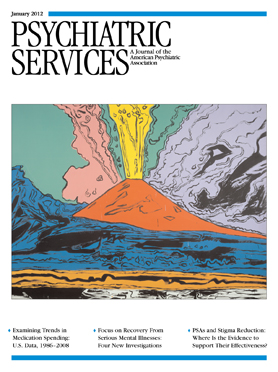This Month's Highlights
Trends in Medication Use
Two articles in this issue examine use of prescription medications—a cornerstone of treatment and, until recently, a key contributor to unprecedented growth in mental health spending. From 1993 to 2003, spending on prescription drugs accounted for nearly half the growth in public and private mental health spending. What do current trends look like, and what factors are key drivers? Tami L. Mark, Ph.D., M.B.A, and colleagues obtained 1986–2008 data from large national databases to document three trends: percentage of enrollees using psychiatric drugs, days supplied per user, and costs per day supplied. In this month's lead article they report that past high growth in medication spending has slowed substantially—from an average annual growth rate of 18.5% in 1997–2001 to 6.3% in 2001–2008. Two factors were key drivers: psychiatric medication cost per day supplied grew at a slower annual rate (2% growth versus 8%), as did the percentage of enrollees using medication (2% growth versus 7%). The authors discuss implications of the slowdown (Original article: page 13). The second article focuses on why programs have been slow to adopt pharmacotherapies for substance use disorders. Adoption has lagged notably in publicly funded programs, where most substance abuse treatment in the United States is delivered. Hannah K. Knudsen, Ph.D., and Amanda J. Abraham, Ph.D., based their approach on sociological theories of organizational decision making. Data from a mailed survey and telephone interviews with 250 administrators of publicly funded substance abuse treatment programs showed that only 37% of programs prescribed any medication for these disorders. The authors found significantly greater odds of adoption among administrators who perceived that their Single State Agency supported such treatment (Original article: page 19).
Criminal Justice System Involvement
In 2007 an estimated 2.1 million people with severe mental illness were incarcerated in the United States. Two studies this month investigated risk factors and the role of symptoms. Using data from San Diego County's jail and mental health systems for nearly 40,000 adult patients, William B. Hawthorne, Ph.D., and colleagues determined risk factors for both incarceration and reincarceration. They found that 11.5% of the patients were incarcerated in a one-year period and that 26.5% of this subgroup were reincarcerated within a year. Risk factors for both groups included co-occurring substance disorders and a diagnosis of schizophrenia or bipolar disorder. Patients who received an outpatient or case management service after incarceration were significantly less likely to be reincarcerated. These findings prompted the county to implement a procedure whereby public mental health clients are seen at an outpatient program within 72 hours of jail release (Original article: page 26). A second study used data from a national survey to determine the rate of legal involvement (being arrested, held at the police station, or jailed) of individuals with bipolar I disorder. Paul P. Christopher, M.D., and colleagues found that 13% of respondents who met criteria for having had a manic episode reported legal involvement during their most severe lifetime episode. Because specific symptoms increased the risk, the authors urge providers to focus on a readily identifiable subset of patients with mania to prevent criminal justice involvement (Original article: page 33).
Focus on Recovery
Recovery from mental illness has been an important focus of research in recent years, much of it guided by the consumer model of recovery, which defines recovery as a process of coming to terms with illness rather than an elimination of symptoms. Four reports in this issue examine recovery from this perspective. The first describes the process of developing the MARS—the Maryland Assessment of Recovery in People with Serious Mental Illness—a 25-item self-report instrument. When Amy L. Drapalski, Ph.D., and colleagues subsequently tested the MARS, their findings indicated its sound psychometric properties (Original article: page 48). Researchers in the Netherlands evaluated a 12-week peer-run course on recovery—“Recovery Is Up to You.” Hanneke van Gestel-Timmermans, Ph.D., and colleagues found that the intervention had significant positive effects on empowerment, hope, and self-efficacy beliefs that persisted three months after course completion (Original article: page 54). A consumer-run mental health center in a New York City suburb was the focus of an ethnographic study by Sara E. Lewis, M.A., L.M.S.W., and colleagues. Interview data showed that program participants experienced themselves as accountable for and to their peers in what amounts to a shared project of recovery (Original article: page 61). In Best Practices, Rob Whitley, Ph.D., and Elizabeth Siantz, M.S.W., describe their qualitative evaluation of a recovery center in New York that provides an array of resources to consumers (Original article: page 10).



